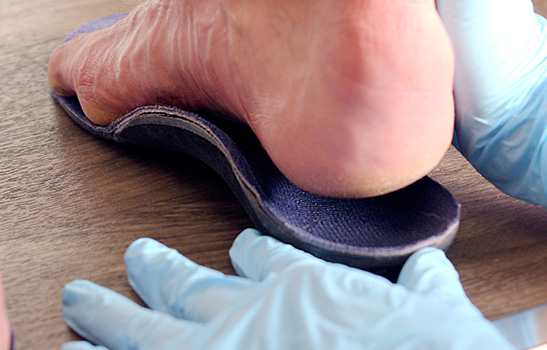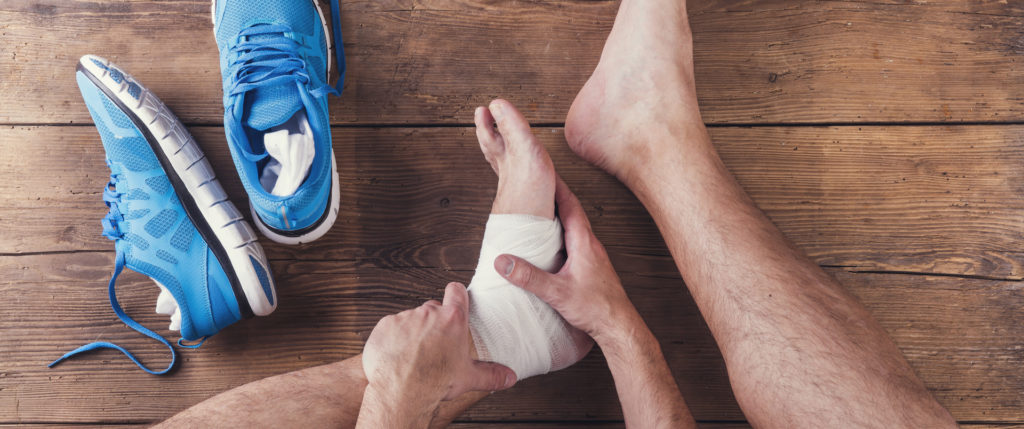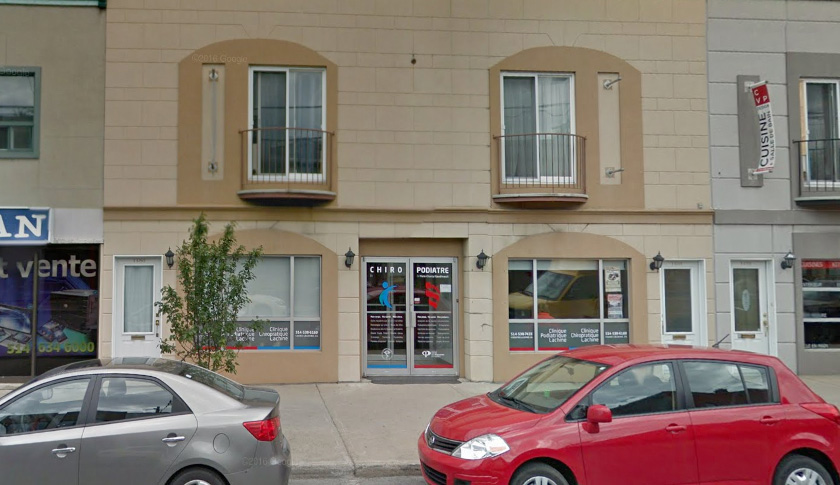Heel spur or calcaneal spur
A heel spur, or calcaneal spur, is an abnormal bone growth under the heel bone. It causes pain directly underneath the heel but can also irradiate into the foot arch.
See the causes See the long term complications See how to relieve yourself at home
Signs and symptoms of a heel spur
- Painful heel with or without pain under the arch
- Pain felt especially at the first steps in the morning or right after a period of rest
- Feeling of pulling, stretching or even ‘‘tearing’’ near the heel
- Some complain of feeling like having a needle under their heel
What are the causes of a heel spur
Heel spurs result of calcium deposits (calcifications) at the site of attachment of the most important ligament in the foot, the plantar fascia. Therefore, it is not an illness per sei but the result of chronic stress applied on this ligament.
It takes several months or even several years for the spur to form. When pain appears, it is really from the ligament rather than from the spur. That is why heel spurs and
plantar fasciitis have the same causes. One must note that both plantar fasciitis and heel spurs can exist concomitantly.
Also, calcaneal spurs can exist but cause no pain. It is not unusual to find a spur under a painless heel on X-rays.
Any mechanical problem causing excessive tension in the foot arch may cause a calcaneal spur, such as:
- Flat feet and hyperpronation;
- Feet with high arches;
- Bunions (HAV) and malfunction of the big toe;
- Lack of calf flexibility;
- Ligamentous hyperlaxity (excess of foot flexibility);
- Leg length inequality
- And more
Moreover, excessive stress of the plantar fascia applied over a long period can also be a cause heel spurs:
- Poorly performed exercises;
- Sports involving repetitive movements, such as running;
- Improper shoes;
- Inadequate working posture;
- Obesity.
All these conditions apply excessive stress on the plantar fascia, most specifically at its insertion in the heel bone. Microscopic tears in the fascia fibers occur and cause swelling (inflammation) at its insertion. When this phenomenon repeats and becomes chronic, calcium deposits (calcification) can form. On X-ray, this process takes the appearance of a horizontal spike located directly under the heel bone but pointing in the direction of walking. Therefore, it is not possible to really feel this bony prominence. In reality, what the patient feels is pain from the pulled and inflamed ligament.
Progression and consequences of a heel spur
The plantar fascia is the most important ligament supporting the foot and is sollicitated in all of its movements. This explains why this type of injury only tends to worsen once implanted. Therefore, while pain was only present in the morning or after a resting period, it tends to become more and more persistent and even impact daily activities. Many athletes have to reduce or even stop their training.
When left untreated, this problem becomes chronic and the ligament thickens by building weaker and less organized fiber structures. This leads to a weaker ligament and recurring injuries. Ultimately, if the ligament is not treated and stress persist, a partial or complete tear of the plantar fascia can occur.
Moreover, the pain experienced under the foot leads unconsciously to change one’s walking pattern, creating compensatory pain to the exterior of the heel, the knee, the hip, or the back.
How to relieve the pain of a calcaneal spur at home
Heel spurs are treated in the same way as plantar fasciitis, here are the three steps:
1. Mechanical rest of the foot:
- Wear laced shoes with a bit of a heel (e.i. running shoes) at all times, even at home.
- Wear prefabricated soles with arch support.
- Reduce activities..
2. Reduce the inflammation:
- Apply ice for 10 to 15 minutes on the aching area, each evening and regularly through the day, depending on the level of pain. Tip-to-note: freeze a water bottle on which you can massage the painful area by rolling your foot over it on the floor.
- Take anti-inflammatory tablets, like Advil or Aleve, following posology and if your health condition permits.
3. Stretching Exercises:
- Read the blog section ‘‘Stretching Exercises for Plantar Fasciitis’’.
- Warm up the foot muscles before taking the first steps in the morning: point your toes, make circles, extend the leg and foot fully, pointing at the ceiling to stretch the calf.
- Massage your arch using a tennis ball for 5 to 10 minutes.
- Stretch calves each morning and each night. This can be performed using a wall, a staircase or using a towel to pull your foot towards you.
Diagnostic of a heel spur
- A thorough biomechanical evaluation is essential to determine if a mechnical misalignment of the foot or if an inappropriate posture is causing the problem.
- X-rays are required to confirm the presence of a heel spur. They also serve to determine other causes of heel pain and to assess the overall bony alignment of the foot.
- Ultrasound is used to examine the health of the plantar fascia, to establish the degree of severity of the problem and to help elaborate the treatment plan. This non-radiative technique allows us to examine the inflamed area, to mesure the thickening of the fascia, to assess orientation of the fiber structures and to confirm or reject any tears. Also, it allows for further diagnosis by examining surrounding structures.
What can my podiatrist do about a heel spur
First of all, your podiatrist is able to confirm the diagnosis and to identiy the specific causes of the problem in order to establish the appropriate treatment plan. As for treating plantar fasciitis, your podiatrist has many tools at his disposal and ensures a follow-up of the condition.
Here is a list of solutions often used to treat heel spurs:
1. Foot Orthotics
Not only are they are used to relieve heel spur pain but are also used to prevent heel spurs and plantar fasciitis when improper biomechanics are identified. Orthotics will
optimize foot mechanics, avoid excessive pulling of the plantar fascia and much more. Learn more about foot orthotics…
2. Ultrasound-guided Cortisone Injection
When the inflammation at the ligament attachment to the spur is important or does not decrease with other treatments, cortisone is the best ‘‘fire extinguisher’’. Instead of using anti-inflammatory medecine by mouth, it is applied directly at the source of pain for a more precise treatment.
3. Radial Shockwave Therapy
Used to treat chronic cases not responding to treatments, this therapy uses the natural healing capacity of the body to re-initiate the healing process. It is effective in 80 to 90 % of chronic cases. Find out more about the radial shockwave therapy…
4. Drug prescription
Sometimes, painkillers, muscular relaxants and/or anti-inflammatory medecine are prescribed.
5. Physical Therapy
- Manual therapy
- Cryotherapy and ultrasound
- Tapings
- Compression socks, splints and walking boots
How to prevent a heel spur
- Wear adequate shoes.
- Change shoes and/or working boots annualy.
- Wear sandals or running shoes for long-standing periods at home (cooking, cleaning, etc.).
- Take action rapidly, as soon as the pain appears, before the problem becomes persistent.
- Wear your prescribed orthosis daily to prevent the apparition of pain.
- Lose weight if overweight.
For athletes:
- Perform a good warm-up before exercising or playing sports.
- Stretch calf muscles after training.
- Follow a progressive training plan, especially for running.
- Diversify your workouts. If you are a runner, practice on different surfaces (grass, dirt road, etc.).
- Change your running shoes every 800-1000 km or if when you notice degradation of the shoe. If you wear lighter shoes or of you are corpulent, you might have to change your shoes every 500 to 700 km. In general, when you start feeling new discomforts, it is an indication that you are due to change your shoes!
I just need to use a pad with a hole under my heel to avoid stepping on my spur!

Even if it really seems like you are walking on a painful spike, in reality the pain is
coming from the stretch in the ligament. The common belief of using a doughnut-shaped
pad under the heel is therefore useless. You must try reduce the tension of the ligament that
supports your foot.
And if it wasn’t a heel spur?
Here are differencial diagnosis of conditions causing symptoms similar to heel spurs or plantar fasciitis:
- Plantar fascia tear
- Heel bursitis
- Myositis of the hallux abductor
- Stress fracture of the heel bone
- Baxter’s neuritis (nerve irritation under the foot)
- Referred pain (inflammation of the sciatic nerve or lumbar compression)
- Panniculitis (inflammation of the fatty layer under the heel)
- Bone tumor
- Systemic disease leading to calcifications (gout, hypercalcemia, lupus, dermatomyositis, rheumatoid arthritis, psoriatic arthritis, ankylosing spondylitis, etc.))


